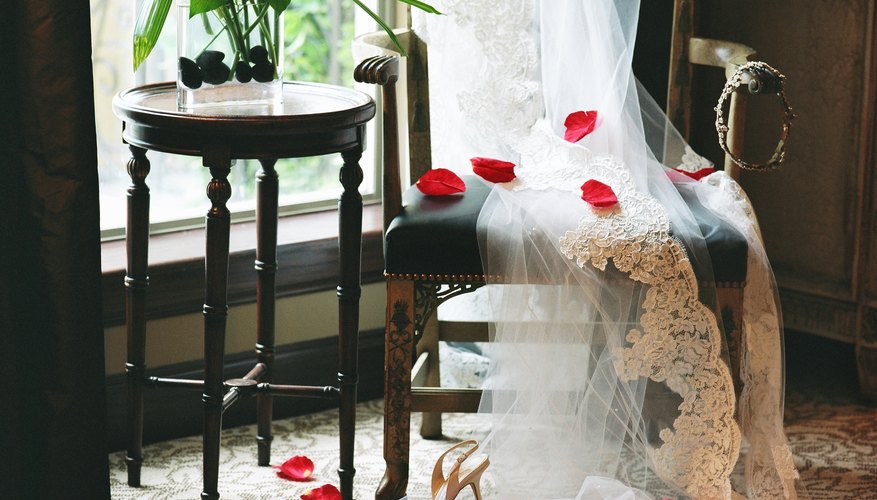Wearing a mother's or grandmother's wedding veil can be a beautiful way to incorporate that special person into your wedding. However, the veil may be 30 or even 50-plus years old, suffering the ravages of time. A common problem with old wedding veils is that they have become yellowed with age. Before you wear your veil, brighten it up with a few careful cleaning steps that will cleanse the fabric and lighten the veil simultaneously. The methods described are all natural and should be safe for lace, tulle or other netting fabrics. However, age will play a major role in what your veil can endure.
- Wearing a mother's or grandmother's wedding veil can be a beautiful way to incorporate that special person into your wedding.
- However, the veil may be 30 or even 50-plus years old, suffering the ravages of time.
Clip off a small piece of the yellowed veil from a portion of the accessory that will not show. Test everything on this piece before applying it to the whole veil to determine what works and, potentially, what will harm or destroy the fabric.
Rinse the veil in a mixture of warm water and lemon juice. You can heat the water on the stove, but do not bring it to boil. Be very gentle with the veil as you saturate it in the lemon juice and water mixture. Add as much as 1 tbsp of lemon juice for each 237 ml (1 cup) of water. This will start to kill any mould or mildew on the veil as well as remove any musty odour. It will also help whiten the veil.
- Rinse the veil in a mixture of warm water and lemon juice.
- Be very gentle with the veil as you saturate it in the lemon juice and water mixture.
Run hot water mixed with baking soda through the veil. As before, use the 1 tbsp per 237 ml (1 cup) ratio. Heat this mixture up and pour it through the veil over a sink. You may need a partner to hold the veil out for you so that you can be sure to get the mixture though every portion of the veil.
Rinse the veil with distilled water. This will get the lemon juice and baking soda out of the fabric. You can either pour the distilled water through the veil or gently rinse the veil in a large pot of distilled water.
Press the veil dry between a white towel. This will absorb a great deal of the water before you hang the veil out to dry. This prevents distortion from hanging a heavy garment up and also speeds the drying process.
- Rinse the veil with distilled water.
- This will absorb a great deal of the water before you hang the veil out to dry.
Drape the veil over the clothes lines to dry. If the veil is exceptionally large and heavy, then you may need to drape it over two clothes lines to distribute the weight more evenly. The clothes lines should be located in the sunshine, since sunshine will interact with the lemon juice rinse to brighten the veil.
Let the veil dry completely, up to 48 hours. If your area is extremely humid, then be sure to bring the veil indoors at night to prevent it from getting damp again. If necessary, you can hang it to dry inside.
WARNING
Remember that old fabric is always delicate, and you may not be able to whiten the veil as much as you wish if it is an antique. If your test fabric deteriorates, do not experiment on the veil itself as you will destroy it. Instead, work with an antique fabric specialist to restore your veil.
